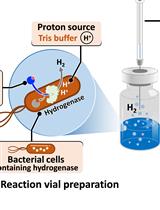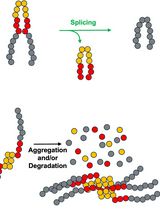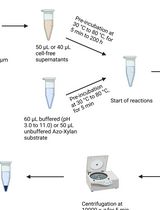- EN - English
- CN - 中文
Assays for the Detection of Rubber Oxygenase Activities
橡胶加氧酶活性测定实验
发布: 2017年03月20日第7卷第6期 DOI: 10.21769/BioProtoc.2188 浏览次数: 8678
评审: Yanjie LiAgnès GroisillierAnonymous reviewer(s)
Abstract
Microbial biodegradation of rubber relies on extracellular rubber oxygenases that catalyze the oxidative cleavage of the double bond of the polyisoprene backbone into oligo-isoprenoids. This protocol describes the determination of rubber oxygenase activities by an online measurement of molecular oxygen consumption via a non-invasive fluorescence-based assay. The produced oligo-isoprenoid cleavage products with terminal keto- and aldehyde-groups are identified qualitatively and quantitatively by HPLC. Our method allows for the characterization of homologue rubber oxygenases, and can likely be adapted to assay other oxygenases consuming dioxygen. Here we describe the determination of rubber oxygenase activities at the examples of the so far two known types of rubber oxygenases, namely rubber oxygenase A (RoxA) and latex clearing protein (Lcp).
Keywords: Latex clearing protein (Lcp) (乳胶清除蛋白(Lcp))Background
Oxygen is a key element in aerobic metabolism and is essential for the catabolism of hydrocarbons. Therefore the quick and accurate measurement of oxygen concentrations in solutions is of interest to monitor oxygen-dependent processes in biotechnology or reactions in biochemistry. Usually a Clark electrode is employed for these purposes. In many cases, however, the use of a Clark electrode is limited due to the necessity of a direct contact of the electrode with the analyte. Some examples comprise turbid solutions in monitoring fermentation processes or complex matrices like colloid latex emulsions as investigated by our research group. Another important aspect distinguishing this protocol from other oxygen detection assays is the very small amount of only 500 µl sample volume required for the in vitro assay. This protocol allows for the rapid and reproducible determination of the oxygen concentration of latex emulsions but likely is transferable to many other applications. In this non-invasive assay, a small sensor spot with a diameter of only ~4 mm is placed in the reaction vessel (cuvette) and comes into contact with the analyte. The sensor spot is excited by light that is emitted by the transmitter unit and guided to the sensor spot via a light conducting cable. The emitted fluorescence light is quenched by dioxygen and the signal intensity is proportional to the concentration of dioxygen. Since oxygen is the co-substrate of polyisoprene cleavage by rubber oxygenases, the activity of the enzymes can be calculated by determination of the oxygen consumption. The second assay describes the extraction of enzyme-produced oligo-isoprenoids with ethyl acetate and their qualitative and quantitative determination by high pressure liquid chromatography (HPLC). For information on the biochemical and molecular biological properties of rubber oxygenases we refer to the following references for RoxA enzymes (Braaz et al., 2004 and 2005; Schmitt et al., 2010; Birke et al., 2012 and 2013; Seidel et al., 2013) and for Lcp (Hiessl et al., 2014; Birke and Jendrossek, 2014; Birke et al., 2015; Watcharakul et al., 2016; Röther et al., 2016).
Materials and Reagents
- Duct tape (e.g., Tesa, extra Power universal)
- 50 ml Falcon tubes (e.g., SARSTEDT, catalog number: 62.559.001 )
- 15 ml Falcon tubes (e.g., SARSTEDT, catalog number: 62.554.502 )
- 2 ml reaction tubes (e.g., SARSTEDT, catalog number: 72.695.500 )
- 0.3 ml limited volume inserts (e.g., Brown, catalog number: 155650 )
- Hot glue
- Silicone Compound (e.g., RS Components, catalog number: 692-542 )
- 1.5 ml tubes (e.g., SARSTEDT, catalog number: 72.690.001 )
- Protein determination assay (e.g., Pierce BCA Kit, Thermo Fisher Scientific, Thermo ScientificTM, catalog number: 23225 )
- Latex milk, 60%, low ammonia (e.g., Weber&Schaer, Hamburg, catalog number: RSS LA )
- Purified rubber oxygenases, Lcp or RoxA of known concentration
- Methanol for HPLC (e.g., VWR, catalog number: 20864.320 )
- Ethyl acetate (e.g., Carl Roth, catalog number: 7338 )
- Nitrogen gas
- Monopotassium phosphate (KH2PO4) (e.g., Carl Roth, catalog number: 3904 )
- Dipotassium phosphate (K2HPO4) (e.g., Carl Roth, catalog number: 6875 )
- Nonidet P-40 (e.g., Sigma-Aldrich, catalog number: 74385 )
- Sodium phosphate buffer (KP), e.g., 100 mM, pH 7 (see Recipes)
- Nonidet P-40 solution (see Recipes)
- Natural rubber latex (see Recipes)
- Diluted colloidal latex buffer (see Recipes)
Equipment
- Oxy-4-mini transmitter (PreSens, catalog number: 200000767 )
- Sharp scissors
- Absorption cells (cuvettes), semi-micro, light path 10 mm, volume 1,400 µl, optical special glass, 4 pieces (e.g., Hellma analytics, catalog number: 114-10-20 )
- Cuvette rack 16 x 1 cm (e.g., Carl Roth, catalog number: CNP5.1 )
- Oxygen Sensor Spots, SP-PSt3-NAU-D5-YOP (PreSens, catalog number: 200000023 )
- 3 mm power drill
- Light conducting cable (2.5 m, 4 pieces, POF-L2.5-1SMA) (PreSens, catalog number: 200000241 ; designated in the manual as ‘polymer optical fiber’)
- Cryo storage box (e.g., Greiner Bio one International, catalog number: 802 202 )
- Magnetic micro stirrer 5 x 2 mm, 4 pieces (e.g., Carl Roth, catalog number: 0955.2 )
- Centrifuge (e.g., Eppendorf, model: 5417 C)
- Autoclave
- Heat-stable container
- Pipette
- Beaker
- HPLC (e.g., Agilent Technologies, model: Agilent 1100 series; DAAD detector at 210 nm)
- LiChrospher 100 RP-8 5 µm endcapped HPLC column (e.g., Trentec, catalog number: 124LP-85ER used in this assay; or alternatively EMD Millipore, catalog number: 150827 )
- HPLC glass vial (e.g., Brown, catalog number: 155710 )
- Fume cabinet
- Laboratory thermometer (e.g., VOLTCRAFT, model: DET1R )
Software
- Oxy4 V2 (Presens, Regensburg, Germany)
- Excel (Microsoft, Redmont, USA)
- Chem Station for LC 3D systems (Agilent Technologies, Waldbronn, Germany)
Procedure
文章信息
版权信息
© 2017 The Authors; exclusive licensee Bio-protocol LLC.
如何引用
Röther, W., Birke, J. and Jendrossek, D. (2017). Assays for the Detection of Rubber Oxygenase Activities. Bio-protocol 7(6): e2188. DOI: 10.21769/BioProtoc.2188.
分类
微生物学 > 微生物生物化学 > 蛋白质 > 活性
生物化学 > 蛋白质 > 活性
生物化学 > 其它化合物 > 氧
您对这篇实验方法有问题吗?
在此处发布您的问题,我们将邀请本文作者来回答。同时,我们会将您的问题发布到Bio-protocol Exchange,以便寻求社区成员的帮助。
提问指南
+ 问题描述
写下详细的问题描述,包括所有有助于他人回答您问题的信息(例如实验过程、条件和相关图像等)。
Share
Bluesky
X
Copy link













